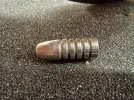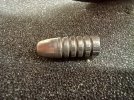This thread could not come at a better time. As you know, I'm working on getting my .32-40 to shoot with PB bullets. I'm a total neophyte to this topic. But between a few of us at Wilton, all shooting single shots in straight-wall BP cases and using smokeless have seen some trends appear. The most striking so far as been the softness (I think this is the more appropriate term in this case) of the alloy.
I started out with 20:1. It's what I used with my .45-70 Shiloh Sharps with a PB Paul Jones bullet. I shot decent with that combination, but never had a partner that taught me much. Wind and mirage were all new to me, iron sight added another variable so it is impossible to say if I could have done better because of simple factors like better condition calls.
I continued with 20:1 for my 03 with GC bullets. Rifle shoots very well and perfect scores out to 500 yards have been achieved with a scope. Those bullets were also about 0.002 over groove diameter.
So, when I moved to PB in the .32-40, I continued on with 20:1. My bore is oversize as some of you know, so I figured I needed 0.002 over groove for that rifle. I ordered a mold and while I was waiting started shooting from borrowed molds that dropped bullets at my 0.326 groove diameter.
20:1 still shot poorly. And while this was going on, another member with a Hepburn that he had relined to .32-40 was also struggling to get his rifle to shoot. We both found indications of leading in our barrels after shooting. I lapped mine with a lead lap and JB Borepaste. He has since done the same. But both rifles continued to shoot poorly. Another member who shoots .32-40 and .25-20SS with PB bullet to great success kept telling us our bullets were too hard. I finally gave in as I had nothing to lose. I went to 30:1. The groups tightened up significantly. And leading ceased.
So, as part of the journey, I was asking others that shot the same caliber with PB bullets with success, how their bullet size compared to bore diameter. One shooter, Craig, pushed a bullet thru his barrels and gave and gave it to me. Then another member, Steve, put a primer and pinch of powder in a case and fired a bullet into a pile of rags and gave it to me. After reading all 3 pages of this thread and the linked thread from 2017 on page 1 of this thread, I took a closer look at those bullets to see what kind of displaced lead existed at the bases created by the lands, and what those tail fins looked like on the base of the bottom band. What I saw I think is significant. Here are some macro photos.
This is Craig's bullet. He pushed this thru his barrel with a rod. Said that it took very little effort. He's using 30:1 or softer.
The indent in the base is from the rod. Note however the skirt formed around the base and the scalloped effect made by the lands engraving the base driving band. I do not see anything that I would call "fragile fins" that could tear or be blown off upon exiting the muzzle. But, this bullet was pushed, not fired.
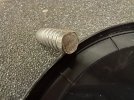
Here is another view at a slightly different angle. What I don't see is a thin fin created. The land seems to have swaged the band rather than engraved the band.
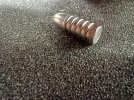
Here is a side view showing how the base band was moved rearward. Again note that it is a smooth scalloped edge, not a ragged or torn find.
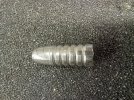
Now here is Steve's bullet. Keep in mind that this was a very light charge, probably just slightly more than the powder of a primer in order to get it to exit the barrel.
Here is the base of Steve's bullet. The roughness is powder residue. There is slight deformation at the land area.
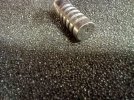
Here is a side view. In this view there is a definite scallop to the edge of the base caused by the land. But it is neither thin nor fragile looking. Also note that the two scallops visible in this photo appear to be very uniform.
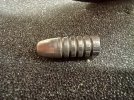
So, like I said, I'm a total newbie to all this stuff. But from what I see here, it does not appear that any thin fins/tails are created by the barrel lands. I do see deformation of the bands and the bottom edge of the base, but that deformation looks uniform to me. I would think that as long as those scallops are uniform and sufficiently robust to remain in place upon exiting the muzzle, they are of little consequence.
Last point from my uniformed opinion is nobody has mentioned the fouling star on the end of the muzzle. Granted, you might not notice it on a radius crown that is blued. But on a flat muzzle that is polished, it is quite clear. If bullets had bases that were loosing pieces and allowing gas to escape on one side, I would expect to see that on the muzzle as a non-uniform star. I could understand that if pieces broke off in different areas on the circumference of the base, then that could with enough rounds fired result in a uniform start. But that would also mean that every bullet engraved differently in the rifling producing a weak fin at different clock positions on the bullet. I would think that would be the result of bullet jump. But since I am breech seating, that should not be an issue.






